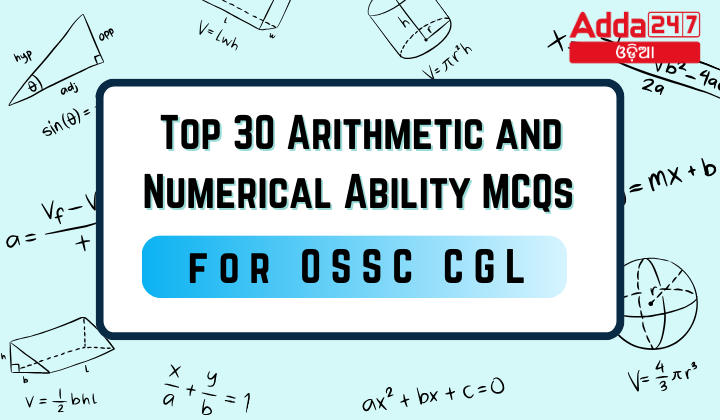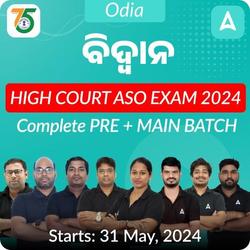Top 30 Arithmetic and Numerical Ability MCQs for OSSC CGL
- Question: The HCF of two numbers is 8 and their LCM is 240. If one of the numbers is 32, find the other number.
[A] 60
[B] 72
[C] 80
[D] 96
Answer: [A] 60]
Solution: Let the other number be x. We know that
HCF×LCM=Product of the numbers.
So, 8×240=32×x. Solving for x, we get
x=(8×240)/32 =60 - Question: The LCM of two numbers is 720 HCF is 4 and their ratio is 4:5. Find the sum of the numbers.
[A] 180
[B] 240
[C] 108
[D] 400
Answer: C [108]
Solution: Let the numbers be 4x and 5x.
We know that
HCF×LCM=Product of the numbers.
So, 720 × 4 =4x×5x
. Since the ratio is given, we know the HCF is 4. Solving for
x, we get x=12
x=9. Hence, the sum of the numbers is
4x+5x=9x=12x 9=108 - Question: The HCF of two numbers is 12, and their LCM is 144. If one of the numbers is 36, find the other number.
[A] 48
[B] 72
[C] 96
[D] 108
Answer: A [48]
Solution: Let the other number be
HCF×LCM=Product of the numbers. So,
12×144=36×x. Solving for x, we get
x= 12×144/36 =48. - Question: The LCM of two numbers is 180. If their HCF is 15 and one number is 45, find the difference of 2 numbers.
[A] 25
[B] 30
[C] 15
[D] 40
Answer: C [15]
Solution: Let the other number be x. We know that
HCF×LCM=Product of the numbers. So,
15×180=45×x. Solving for
x, we getx= 15×180/ 45 =60.
Hence, the other number is
x=60−45=15. - Question: The HCF of two numbers is 6, and their LCM is 210. If one of the numbers is 18, find the difference of 2 numbers.
[A] 52
[B] 40
[C] 45
[D] 50
Answer: A [52]
Solution: Let the other number be x. We know that
HCF×LCM=Product of the numbers. So,
6×210=18×x. Solving for x, we get
x= 6×210/18 =70. Hence, the difference of number is
x=70−18=52. - A prime number N. in the range 10 to 50, remains unchanged when its digits are reversed. The square of such a number is
(1) 1936
(2) 1089
(3) 484
(4) 121
Answer:(4) 121
Sol: A prime number N from 10 to 50 which on interchanging the digits remains same is 11, so its square is 121. - A four-digit number formed by repeating a two digit number is always exactly divisible by
(1) 7
(2) 19
(3) 83
(4) 101
Answer:(4) 101
Sol: All the four digit numbers which are formed by repeating a two digit number are always divisible by 101. - If a, b, c,…. x26 natural numbers, then the value of (x – a)(x – b)(x – c) … (x – y)(x – z) is
(1) 0
(2) 1
(3) 13
(4) 26
Answer:(1) 0
Sol: 14. If a, b, c, …, x, y, z are 26 natural numbers, then
(x-a)(x-b)…. (x – x)(x – y)(x – z) =(x-a)(x-b)… 0(x – y)(x – z) = 0 - If a six-digit number 93p 25q is divisible by 88, then the values of p and q are respectively
(1) 2 and 8
(2) 8 and 2
(3) 8 and 6
(4) 6 and 8
Answer:(3) 8 and 6
Sol: 15. If 93p 25q is divisible by 88 then it must be divisible by 8 and 11 both. We test the divisibility by 8 first, for that the last three digits must be divisible by 8 i.e., 25q is divisible by this gives a = 6 When the number is divisible by 11, then (9 + p + 5) – (3 + 2 + q) must be zero or multiple of 11, this gives us 14 + p – 11 =3+p Rightarrow p=8 - Consider the following statements
1. The sum of two prime numbers is a prime number.
2. The product of two prime numbers is a prime number. Which of these statements is/are correct?
(1) Neither 1 nor 2
(2) 1 alone
(3) 2 alone
(4) Both 1 and 2
(5) None of these
Answer:(1) Neither 1 nor 2
Sol: Neither the sum of two prime numbers is always a prime number nor their product is prime. - If a and b are such numbers that a > 0 and b <0, then which one of the following is always correct?
(1) a-b>0
(4) a – b < 0
(2) a + b > 0
(3) a + b < 0
(5) None of these
Answer: (1) a-b>0
Sol: Ifa > 0 and b < 0 then a – b > 0 is always true as if suppose b = – p < 0 then a – b = a – (- p) = a + p > 0 which is always true. - The sum of the numerator and denominator of a certain fraction is 8. If 2 is added to both the numerator and the denominator the value of the fraction is increased by 4/35, then the fraction is
(1 ) 1/7
(2) 3/5
(3) 5/3
(4) cannot be determined
Answer:(4) cannot be determined
Sol: cannot be determined - In a number of three digits, the digits in the unit’s place and the hundred’s place are equal and the sum of all the digits is 8. The number of /such numbers is
(1) 3
(2) 4
(3) 5
(4) 6
Answer:(1) 3
Sol: The numbers of three-digits having unit’s place and the hundred’s place equal can be 611, 422 and 233. So, there are only three such numbers. - In (337)^337, the unit digit is occupied by
(1) 1
(2) 3
(3) 7
(4) 9
Answer:(4) 9
Sol: To find the unit digit of 337^337
, we can use the concept of cyclicity of unit digits.
Let’s first find the cyclicity of the unit digit of 337:
337^1 =337→unit digit=7
337^2 =113369 →unit digit=9
337^3 =38272753→unit digit=3
337^4 =28880041761→unit digit=1
Now, notice the pattern: the unit digit of powers of 337 follows the cycle: 7, 9, 3, 1.
Since the exponent 337 is one more than a multiple of 4, the unit digit of 337^337 will be the next number in the cycle after 7, which is 9.
Therefore, the unit digit of 337^337=9 - 36 * 45 + sqrt ? =1700
(1) 640
(2) 360
(3) 80
(4) 6400
Answer: (4) 6400 - 12 ^ 2 + 16 =
(1) 180
(2) 160
(3) 240
(4) 156
Answer: (2) 160 - 2 whole 3/5 + 4 whole 1/5 – 3 whole 2/5 =
(1) 3 whole 1/5
(2) 3 whole 4/5
(3) 4 whole 2/5
(4) None of these
Answer: (4) None of these - 3785+?-4297= 5523
(1) 6125
(2) 6035
(3) 6025
(4) 6135
Answer: (2) 6035 - 11.02 * 8 + 1.5 * 0.6 =
(1) 89.06
(2) 89.60
(3) 89.96
(4) 89.26
Answer: (1) 89.06 - 3/5 of 4/7 of 7/9 of 1380 = ?
(1) 378
(2) 376
(3) 368
(4) 386
Answer: (3) 368 - 75% of 580 + 58% of 750 =
(1) 840
(2) 860
(3) 680
(4) 870
Answer: (4) 870 - Among the following fractions, the largest fraction is
(1) 10/11
(2) 0.91
(3) (7 * 3)/6
(4) (8 * 3)/9
Answer:(2) 0.91
Sol. 10/11 = 0 (7 * 3)/8 = 0 * 9125 , , (8 * 3)/9 = 0 * 9222 - The rational numbers lying between 1/3 and 3/4 are
(1) 97/300 ,299 /500
(2) 99/300 , 301/400
(3) 95/300, 301/400
(4) 117/300, 287/400
(5) None of these
Answer:(4) 117/300, 287/400
Sol. 1/3 = 0 * 33334 117/300 = 0 .3900 and 287/400 = 0 . 7175, 117/300, 287/400 lies between 1/3 and 3/4 - Arrangement of – 3/7, 2/3 and – 1/3 in the ascending order is
(1) – 3/7, – 1/3, 2/3
(2) 2/3, – 1/3, – 3/7
(3) – 1/3, – 3/7, 2/3
(4) – 3/7, 2/3, – 1/3
Answer:(1) – 3/7, – 1/3, 2/3
Sol. – 3/7 = 0.4285, 2/3 = 0.6667 and – 1/3 = 0 . 3334 So, the ascending order is given by 0.4285 < – 0.3334 < 0.6667 – 3/7 < – 1/3 < 2/3 - (6.5×6-5-45.5+3.5×3.5) is equal to
(1) 10
(2) 9
(3) 7
(4) 6
Answer:(2) 9
Sol.6. 5 * 6 . 5 – 45 .5 + 3.5 * 3.5 =(6 .5) ^ 2 – 2 * 6 .5 * 3.5 + (3.5) ^ 2 = (6.5 – 3.5) ^ 2 = (3) ^ 2 = 9 - Given that 0.111…= 1/9 , 0.444 is equal to
(1) 1/90
(2) 2/45
(3) 1/99
(4) 4/9
Answer:(4) 4/9
Sol.0*1111…= 1 /9 , so 0*444…= 4 * 0 .111 … = 4 * 1/9 = 4/9 - The smallest possible three place decimal is
(1)0.012
(2)0.123
(3)0.111
(4) 0.001
Answer:(4) 0.001
Sol.The smallest possible three place decimal is 0-001. - (16 ^ 0.16 * 2 ^ 0.36) is equal to
(1) 2
(2) 16
(3) 32
(4) 64
Answer:(1) 2
Sol. 16 ^ (0 * 16) * 2 ^ 36 = 2 ^ (4 * 0 * 16) * 2 ^ 36 = 2 ^ (64 + 36) = 2 ^ 100 = 2 - On simplification of{ ( 2. 644 )^ 2 -(2.356)^2} /0.288 we get
(1) 1
(2) 4
(3) 5
(4) 6
Answer:(3) 5
Sol. { ( 2. 644 )^ 2 -(2.356)^2} /0.288= (2. 644 +2.356)(2. 644 -2.356)/0.288=5*0.288/0.288=5 - The value of ( 243 )^ 0.16 x (243)^0.04 is equal to
(1)0.16
(2) 3
(3) 1/3
(4)0.04
Answer:(2) 3
Sol.( 243 )^ 0.16 x (243)^0.04=( 243 )^0.2=(3)^5*0.2=3
















